Apple Scionwood
Welcome to our collection of apple scionwood. We grow over 130 varieties of apples and offer scions for grafting from most of them.
For filtered search - we have apples organized by categories and tags. Use the filter below to select as many categories and tags as you want to narrow down your search. For the most specific results, select just one category and multiple desired tags. Full functionality is coming soon - we are continuing to update each variety with all the correct categories and tags. Feel free to reach out with questions about specific varieties.
Categories:
Cider apples (good for hard ciders)
Dessert apples (also known as snacking apples, good for fresh eating)
Baking/saucing apples (also known as culinary apples, good for canning, preserving, baking, and cooking)
Red Flesh (red or pink flesh on the inside)
Tags:
Cold hardy (good for extreme cold or Northern climates)
Disease-resistant (has moderate to strong resistance to one or more common apple diseases)
Harvest period early, mid, or late
Heat or low-chill tolerant (good for extreme warmer or Southern climates)
Heavy producer
Pollination Groups A through E
Ordering is now open for this season. Order now for shipping between January and April 2025. Questions? Please contact Christina Fordyce at 503-930-8280 or fordycefarminc@gmail.com.
Scion wood is sold by the piece, except for some varieties that are available in bulk quantities of a 20-pack. We always seek to provide sticks that are close to 12” and pencil thickness at the base but every variety grows differently and so thickness varies.
We ship only within the United States. We do not ship internationally. Rootstock does not ship to California.
Return/Refund Policy: We do not offer returns or exchanges on scionwood or rootstock. We have a 30-day return policy on our clippers (must be unused and returned in original packaging. Return label must be requested). If we have made an error on the scionwood variety you have ordered, we will refund or replace the incorrect item. Claims for errors in your order must be presented within 30 days of receipt of your order. Claims must include a picture of the error and sent to us by email at fordycefarminc@gmail.com. Failure to assert claims within 30 days after order receipt renders this warranty null and void.

This apple originated in the Ukraine in the 1700s. It made it’s way to the U.S. in the 1800s and over the Oregon trail to Oregon in the mid-1800s among the first named varieties brought here. It’s a lovely and tasty apple that has a fair amount of disease resistance. Ours grow in an non irrigated part of the orchard and survived hot dry summers with ease. Generally they produce only enough for our use so we don’t often stock scionwood for these.

This late August apple is disease resistant, productive and vigorous. A 1930s German apple has Cox Orange Pippin and the Duchess of Oldenburg as its parents. It’s an apple with a margarita trapped inside. It’s so juicy it drips down your chin and yet it’s still firm. It’s so refreshing with its limeade flavor.
Categories: cider apple, dessert apple, baking/saucing apple
Tags: Heat/low-chill tolerant, Disease-resistant, Heavy producer, Harvest period mid, Pollination Group B

Red-fleshed, dark red skin these apples are in high demand from both chefs and canners. These have the flavors of raspberries and blackberries in them and are relatively tart. These ripen in mid-August and have the best disease resistance of our red-fleshed apples. We have had relatively good success grafting these but not 100% success. Scion pieces tend to be slightly skinnier than a pencil.
Categories: Red Flesh, dessert apple, cider apple, baking/saucing apple
Tags: Disease-resistant, Harvest period early, Pollination Group D

READ FULL DESCRIPTION. These apples with nearly black skin are from Bentonville, Arkansas and the 1870s. We think the ones from our orchard have a distinctly spicy flavor. These are coveted by cider makers for their complexity and intensity. These are very late season apples. These trees are slower growing and we have a small number of them so scion wood is limited and tends to be smaller than average.
NOTE ABOUT ORDERING: Some pieces we have in stock on this variety are only about 4” long. We usually try to cut a foot long piece, but these are slow growing and we usually sell out of the long pieces. The small pieces are still big enough to graft, but we are offering them at a discounted price because of the smaller-than-standard sizing.
Categories: cider apple, baking/saucing apple
Tags: Harvest period late, Pollination Group D, Disease-resistant

From Gloucester, England and the 1700s. Rowan Jacobson describes the flavor of these as “like a tart homemade lemonade.” He suggests you wait until December to eat these but that depends entirely on how much you like tartness in an apple. These highly russetted apples are reasonably disease resistant. The trees are both productive and vigorous. The scion from them tend to be thicker than a pencil.
Categories: dessert apple, cider apple, baking/saucing apple
Tags: Disease-resistant, Harvest period late, Pollination Group D

From the Netherlands of the 1850s. We’re super fans of these apples. They start out tart but age into a true nutty but intensely apple flavor. These also make a fantastic single varietal hard cider. The trees are productive and highly disease resistant. They are vigorous growers and graft easily. The apples are fantastic eaten fresh, baked or fermented. We think these should be on every homestead and in every commercial orchard.
Categories: dessert apple, cider apple, baking/saucing apple
Tags: Disease-resistant, Heavy producer, Cold hardy, Harvest period mid, Pollination Group C

Originally found as a wild seedling in Switzerland in the 1880s. This is a good, medium sized dessert apple. Yellowish green under a deep red. This variety can tend to be biennial. Responds well to pruning.
Categories: baking/saucing apple, dessert apple
Tags: Harvest period late, Pollination Group D

From 1740 England. We love their intense flavor, nuttiness and bit of spice. In England these are popular for apple charlotte. It is one of the parents of the legendary Cox Orange Pippin. These produce every other year but their apples are almost always perfect. They resist all the fungal diseases here. We’ve had success grafting them. They are a very late apples, among the last to ripen in our orchard.
Categories: dessert apple, baking/saucing apple
Tags: Disease-resistant, Heavy producer, Harvest period late, Pollination Group D

These are out of New England in the late 1700s. They have a powdery blue bloom. Their unique flavor has been described as tropical. Henry David Thoreau listed them as a favorite cultivated apple, being more like the wild ones. These have some disease resistance, are late season apples and fairly vigorous growers.
Categories: dessert apple, baking/saucing apple
Tags: Cold hardy, Harvest period late, Pollination Group C

Firm, very late season apple that will survive temperatures as low as 26 degrees and just get sweeter. Commercial apples from the 1950s and New Zealand. Very scab prone in wet conditions.
Categories: dessert apple, baking/saucing apple
Tags: Harvest period late, Pollination Group E

Bramley’s Seedling: this is a classic English cooking apple. They are great for growers as they’re productive, vigorous trees. The apples are very resistant to disease and often grow quite large. They really are among the best apples anywhere for sauce and pies. The scion wood is hardy and fairly thick. We have bulk quantities of the scionwood. Contact us for pricing on orders over 60 pieces.
Categories: baking/saucing apple, cider apple
Tags: Disease-resistant, Heavy producer, Harvest period mid, Pollination Group D

From Normandy, France 1598. These are prized by French chefs for baking. Hard, crunchy and intensely lemony. These are late season apples with a lovely lobed shape. They make a wonderful single varietal cider. We find these apples modestly challenging to grow organically being somewhat susceptible to scab and scale. We have had much success grafting this variety.
Categories: baking/saucing apple, cider apple
Tags: Harvest period late, Heavy producer, Pollination Group D

Queener Farm has only offered Cameo apple scionwood for a couple years. For years the trees had been too scab infected to produce marketable fruit and lacked vigor. After the farm switched to a nutrient based program, they responded with gusto. The apples were near perfect and the trees thrived and grew. They also handled the “heat dome” of 2020 with temperatures reaching 115 remarkably well. They had no protection and experienced minimal sunburn and no bitterpit response. If you are in an area with little scab or you have a program for dealing with it these can be a lovely addition to your orchard.
Categories: dessert apple, baking/saucing apple
Tags: Harvest period mid, Pollination Group A
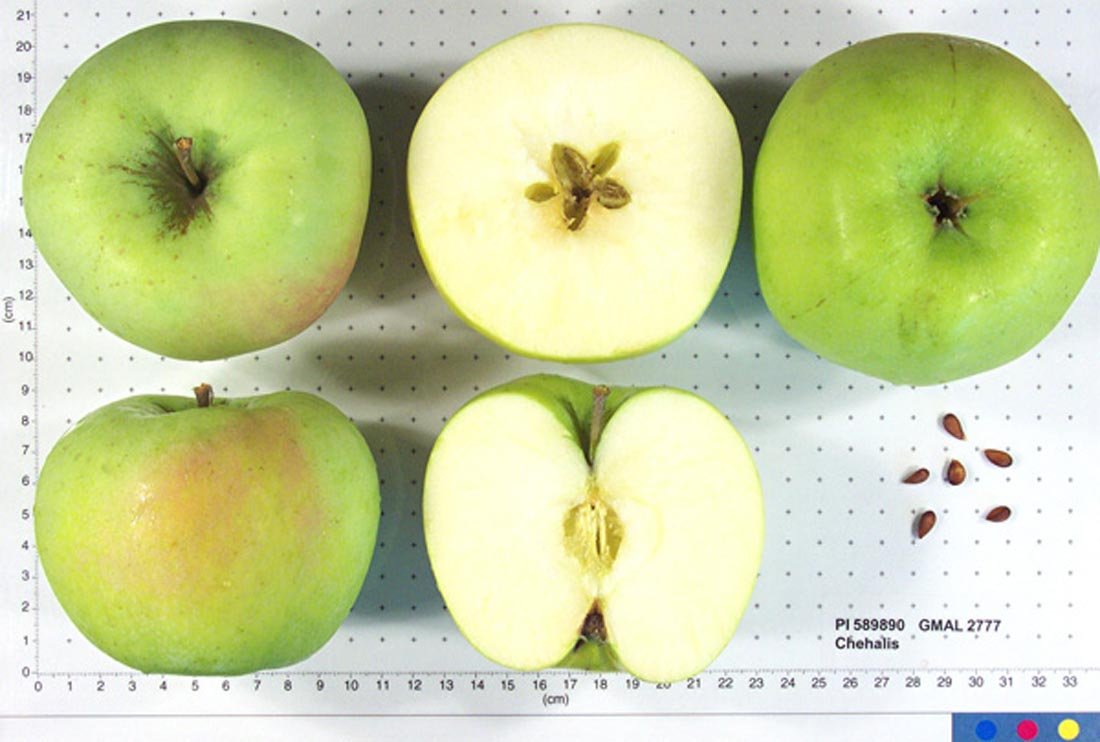
These originated in the 1930s from a seedling of a Golden Delicious raised by Lloyd Lonburg of Oakville, WA - so these are a PNW native! They bruise easily, so handle them with care! Great for fresh eating and pies. Lasts about 2 months in cold storage.
Note: this apple scionwood is harvested from Fordyce Farm inc. that we operate in Salem, OR. Fordyce Farm inc. is not certified organic.
Categories: dessert apple, baking/saucing apple
Tags: Disease-resistant, Heavy producer, Harvest period early, Pollination Group D

These apples look and taste a little quince like. They are coveted for cooking but are also tasty as a sliced up dessert apple paired with a nice cheese. They hold reasonably well and so you can display them in a bowl for a while before eating them. These tend to ripen over several weeks. We pick them from early August into September. They have decent disease resistance and are productive every year. Excess heat can make them drop their fruit early. We’ve found them quite easy to graft.
Categories: dessert apple, baking/saucing apple
Tags: Harvest period early, Pollination Group D

A lovely round apple with a slight orange cast. Introduced in 1825, it’s considered the benchmark for apple flavor. They are notoriously disease prone but we've found they are easier to get nice apples from than many others with little disease resistance.
Categories: dessert apple, cider apple, baking/saucing apple
Tags: Heavy producer, Harvest period mid, Pollination Group C
It originated in the U.K. in 1949 and is likely from a seedling of the Worcester Pearmain. It was first named Thurston August for the town of a nursery it was raised in and for the month it could produce, being an earlier variety. It was renamed to Discovery in the 60s. This delicious apple has a sweet tart flavor some also describe as strawberry-like. Very slow to oxidize when slices exposed to air.
Categories: baking/saucing apple, dessert apple
Tags: Pollination Group D, Disease-resistant, Harvest period early
These small apples are rather oval-shaped and the size of a golf ball or smaller. They are a nice deep red and have a bloom. These are sweet-sharp and a little bitter and is best used for jellies, as a sweet-sharp in ciders, or as an ornamental. (We will often use it in holiday centerpieces!) It originated in St. Petersburg, Russia in the 1890s. Its heavy pollen and long bloom period makes it an excellent pollinator for either home orchards or large scale operations.
Categories: cider apple, baking/saucing apple
Tags: Disease-resistant, Heavy producer, Harvest period mid, Cold hardy
An 18th century Russian apple. These early apples are wonderful for sauce and are recommended for drying. These are quite productive trees but are fairly disease prone. They have improved under organic care but they should be watched closely for fire blight. They tend to have less scab than some but they also will drop quickly if there is excess heat. They add nice aromatics to a cider.
Categories: cider apple, baking/saucing apple
Tags: Heavy producer, Harvest period early, Pollination Group B
Information on Dummelow Seedling is fairly scarce and contradictory. We are now fairly certain these are not the traditional English Dummelow. That said, they are in two places in our orchard, clearly labeled and planted at two different times and the apples are the same. They were planted by an English orchardist. The oddest shaped apple we grow with a flavor that is completely unique. It’s an apple, sort of, it seems to have some pear genes in it. We enjoy its floral qualities. These have blooms with no petals and we’ve not seen bees pollinating them but they do set reasonable amounts of fruit. A very fun apple for those who go for a wildly diverse orchard.
Categories: baking/saucing apple, dessert apple
Tags: Harvest period early
A sweet apple with juicy white flesh and a crisp texture. We find these to be delicious to eat and nice for the base of a hard cider but their susceptibility to fungal diseases makes them a challenge in our warm wet springs. They are, however, resistant to blight and rust. Early to bloom but late to ripen.
Categories: dessert apple, cider apple, baking/saucing apple
Tags: Disease-resistant, Heavy producer, Harvest period late, Pollination Group C
This variety is from 1920s Germany and we’re big fans of these apples. They’re crunchy, tasty, aromatic and almost always as near to perfection as can be expected in an organic orchard. Child of the Duchess of Oldenburg. These have resistance to anthracnose. The tree is biannual but highly productive and nearly free of both scab and insect damage. It is a small, fairly late season, apple.
Categories: dessert apple, cider apple, baking/saucing apple
Tags: Disease-resistant, Heavy producer, Harvest period late, Pollination Group B
This is famous as Thomas Jefferson’s favorite apple. It’s from New York and the early 1800s. This rich, firm fleshed apple is full flavored. Its spicy taste makes it one of our favorites, it’s susceptibility to every disease apple trees can get makes it an ongoing challenge. Dark almost orange/red apples that aren’t perfect but are delicious. These will keep and are famous for being best in late December.
Categories: dessert apple, cider apple, baking/saucing apple
Tags: Harvest period mid, Pollination Group D
The mysterious U.S. version of an apple that was thought to be a famous English cider apple. Foxwhelp is known for its superior hard cider and is originally from the U.K. It was discovered some time ago through DNA testing that the Foxwhelp variety that was brought to the States and catalogued by the USDA was actually NOT the famous U.K. cider bitter. So the scions distributed through the U.S. from that collection were something altogether different. This U.S. version came to be known then as “Fauxwhelp” to denote the difference. However, it has been shown to be a good fresh eating apple, saucing apple, and still excellent for cider blends. Bittersharp with some tannins, high acidity, and relatively sweet.
Read more about this infamous mix-up at Cidercraft Magazine.
Categories: cider apple, baking/saucing apple, dessert apple
Tags: Harvest period early
These highly disease resistant, very productive, late season apples are favorites on the farm. Our trees have been vigorous growers that produce piles of nearly perfect apples with little attention from us. Yellow, tart, late season and good storing fruit. We hadn’t offered these before because we were keeping all the scion for our own grafting.
Categories: cider apples, dessert apples, baking/saucing apples
Tags: disease-resistant, heavy producer, heat/low-chill tolerant, Harvest period late, Pollination Group E
We take Golden Delicious scion only from the oldest trees on our orchard. These large, standard, over 60 year old trees produce apples that are noticeably richer in flavor than the younger, under 20 year old, trees. It’s unclear if this is the result of genetic differences that come from years of selection or if the large, old trees access nutrients not available to the others. A dead, ripe Golden Delicious is an amazing apple and as commercial ones are picked much too early for any real flavor it’s only experienced by those with these historic trees.
Categories: dessert apple, cider apple, baking/saucing apple
Tags: Cold hardy, Harvest period late, Pollination Group D
This popular garden variety originated in the UK back in the 1800s. It is pale green to golden yellow and can be lightly russeted. Best used for pie or juice. Keeps for months in storage.
Categories: baking/saucing apple
Tags: Harvest period late, Cold hardy
Everyone knows this large green tart apple. Very late season. To taste it like only those who grow it can, leave it on the tree until December, even January. It sweetens up but maintains the legendary acidity and tastes like tart apple candy. This is available in bulk quantities.
Categories: baking/saucing apple
Tags: heat/low-chill tolerant, Harvest period late, Pollination Group C
We have both the Red Gravenstein and the traditional pictured here. One of the best early ripening cooking apples. Our farm has many Gravenstein trees and has grown these apples for over 40 years. We take scion only from either the small group of very red Gravenstein where all the apples are solid red, slightly smaller and ripen a little later or the section of trees that are consistently traditional Gravenstein in size, coloration and ripening. They all have the amazing Gravenstein flavor. We have bulk quantities of this variety.
Categories: baking/saucing apple, cider apple, dessert apple
Tags: Heat/low-chill tolerant, Heavy producer, Harvest period early, Pollination Group A
Discovered in 1790 and so loved that there is a monument to the first Golden Grimes tree at its home in West Virginia. A delicious apple that also was a favorite among cider makers and moonshiners. Still fairly common in the south. Green apples that a turn a lovely yellow. They are a mixed bag in terms of disease resistance.
Categories: cider apple, dessert apple, baking/saucing apple
Tags: Disease-resistant, Heat/low-chill tolerant, Southern US Roots, Harvest period mid, Pollination Group D
Our favorite very late season apples because these produce lovely, tasty apples even when weather wrecks most of the others. It’s never too hot for them, it never rains enough to split them. From the hills above Santa Cruz in the 1890s. These are on the Slow Food Ark of Taste. These have good disease resistance, handle heat and rain. They are highly productive every year. We’ve had good success grafting them.
Categories: dessert apple, cider apple, baking/saucing apple
Tags: disease-resistant, heavy producer, harvest period late, Heat/low-chill tolerant, Pollination Group F
An apple from 1918. One of our favorites and another “trifecta apple” great for eating, baking and cider. Fans of the Holstein recommend keeping them cool until the color changes from green to yellow. These apples have a distinctive russet on the bottom that often cracks, that cracking is their only “flaw”.
Categories: dessert apple, cider apple, baking/saucing apple
Tags: disease-resistant, Harvest period mid, Pollination Group C

We collect scion wood only for the handful of trees that bear the reddest apples. Some see the red Gravenstein as a separate variety and some don’t. Compared to our other Gravenstein we find these to be slightly later, slightly sweeter and they stay on the tree slightly better. The trees we collect from bear almost entirely fully red apples. We have these in bulk quantities.
Categories: cider apple, baking/saucing apple, dessert apple
Tags: Pollination Group A, Heavy producer, Heat/low-chill tolerant, Harvest period early

Red Spy: a redder sport of the more common Northern Spy. These late ripening, long keeping apples were developed in New York in the 1840s. Whereas Northern Spy apples have some green background to the skin these are all red.
Categories: baking/saucing apple, dessert apple
Tags: Harvest period late, Pollination Group E, Cold hardy

This is a rare red-fleshed apple. Apparently this apple is also known as Bill’s Red Fleshed and Firecracker and was introduced in our home state of Oregon. These are quite tart and one grower recommends cutting it into slices and putting those in lemonade to make it pink.
Categories: dessert apple, Red Flesh
Tags: Harvest period early, Pollination Group D

These large, dimpled apples have a unique appearance with their thick stems. It originates back from the late 1700s and is named for John Starr whose New Jersey property it popped up on as a seedling. It became popular for its large size in the mid-1800s. As an early apple it was sometimes picked before peak ripeness and used for baking. It is tart and juicy.
Categories: baking/saucing apple, dessert apple
Tags: Harvest period early
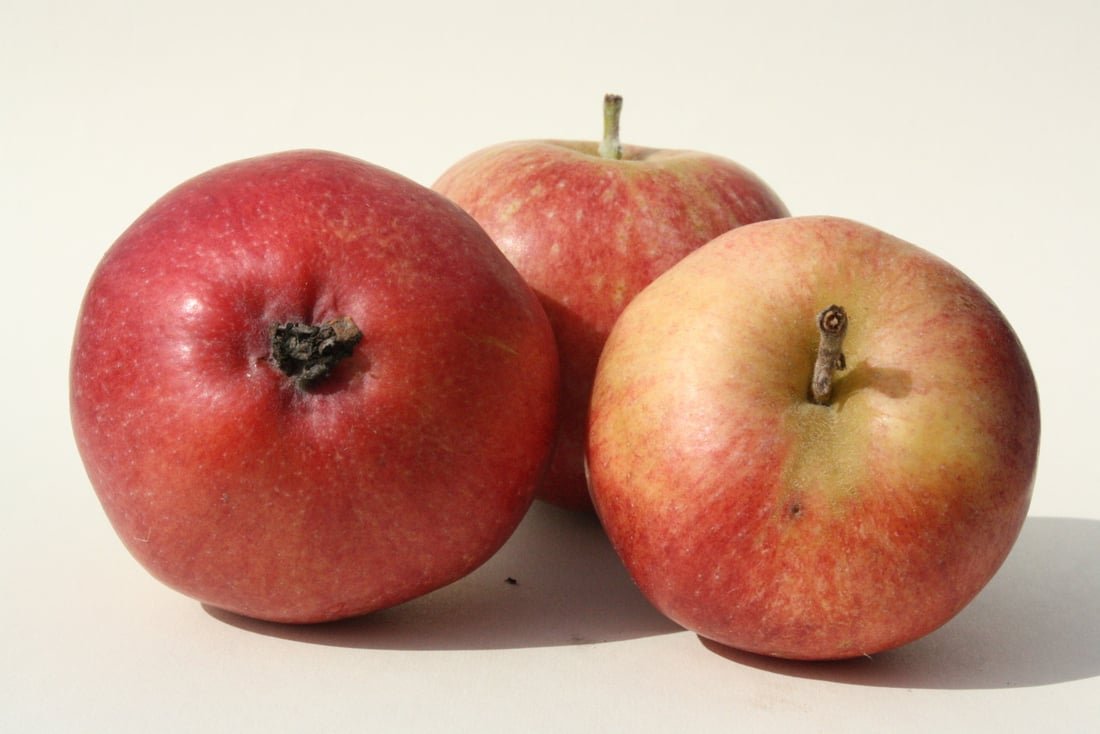
Also known as Wickson Crab. This is an Albert Etter variety. Tart, reddish, and striped, the Wickson parentage is a little obscure, but may be a cross between the Esopus Spitzenburg and the Newtown Pippin. Favored for crab apple jellies because of the high pectin content. It blossoms early so it is a good pollinator for other apples.
Categories: baking/saucing apple, dessert apple, cider apple
Tags: Heavy producer, Pollination Group C, Harvest period mid

A 1980s apples from the south these are one of the varieties that may carry apple farmers into the post climate change era. They clearly require less chill hours and they are beloved in the south because in an area with rampant fungal disease, they do well. These require very little attention to do well and are great for the novice grower. One of the best tasting early apples. Developed as part of the PRI breeding program.
Categories: baking/saucing apple, dessert apple
Tags: Pollination Group A, Disease-resistant, Heavy producer, Heat/low-chill tolerant, Harvest period early, Southern US roots
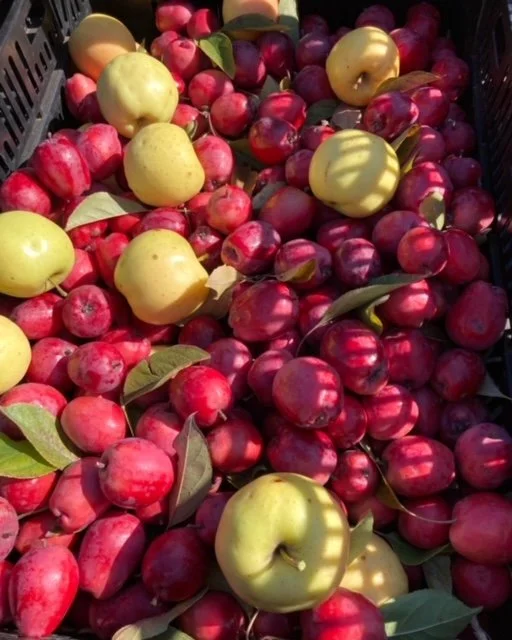
This small late season apple has dark red flesh and a lovely sweet tart taste. Good for eating, winter decorating, fine apple jellies and preserves. Trees are lovely when in bloom and in fall with bright red fruits. Ours tend to have darker red flesh than many pictures of “Winter Red Flesh” we see online. Typically these trees produce very little scionwood. Tends biennial.
Categories: Red flesh, dessert apple, baking/saucing apple
Tags: Harvest period late, Cold hardy
Airlie Red Flesh
Akane
Alexander (Aporte)
Alkmene
Almata, (red flesh)
Ambrosia
Amere de Berthecourt
Anna
Arkansas Black
Ashmead's Kernel
Baldwin
Belle de Boskoop
Berner Rosen
Blairmont
Blenheim Orange
Blue Pearmain
Braeburn
Bramley Seedling
Calville Blanc d'Hiver
Cameo
Centennial
Chehalis
Coles Quince
Corail (Pinova & Pinata)
Cornish Gillflower
Cortland
Cox's Orange Pippin
Dabinett
Devonshire Crimson Queen
Discovery
Dolgo
Duchess of Oldenberg
Dumelow's Seedling
Empire
Enterprise
Egremont Russet
Erwin Bauer
Esopus Spitzenberg
Fiesta
Foxwhelp/Fauxwhelp
Fuji - jubilee
Fuji - yataka
Gala
Giant Russian Crab
Gingergold
Glockenapfel
Gold Rush
Golden Delicious
Golden Noble
Granny Smith
Gravenstein
Grimes Golden
Hauer Pippin
Hawkeye
Herefordshire Redstreak
Hidden Rose, (red flesh)
Holstein
Honeycrisp
Hubbardston Nonsuch
Jonagold
Jonathan
Karmijn de Sonnaville
Kerr Crab
King of Tompkins
Kingston Black
Knobbed Russet
Lady
Lady Williams
Laxton Superb
Liberty
Lodi
Lubsk Queen
Lyman's Large Summer
Major Apple
McIntosh
Melrose
Mollie’s Delicious
Monark
Mother
Muscadet de Dieppe
Mutsu
Newtown Pippin
Niedzwetzkyana (red flesh)
Northern Spy
Opalescent
Oriole
Orleans Reinette
Parentene
Peasgood Nonsuch
Pierce Pasture
Pink Pearl
Porter’s Perfection
Queen Bee
Queen Cox
Queener Donut
Red Gravenstein
Red Spy
Redfree
Reverend W. Wilkes
Ribston Pippin
Rubinette
Rusty Coat
Sansa
Scarlet Surprise
Sekai Ichi
Senshu
St. Edmunds Pippin
Starr
Summer Rambo
Sundance
Suncrisp
Surprise
Sweet Delicious
Tremblett's Bitter
Washed Russet
Whitney crab
Wickson
Williams Pride
Winter Red Flesh
Wynoochee Early
Yarlington Mill
Yellow Bellflower
York
Zabergau Reinette
20 oz.



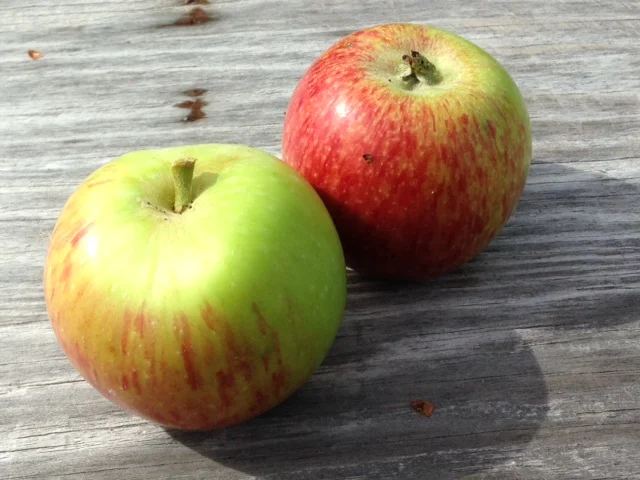






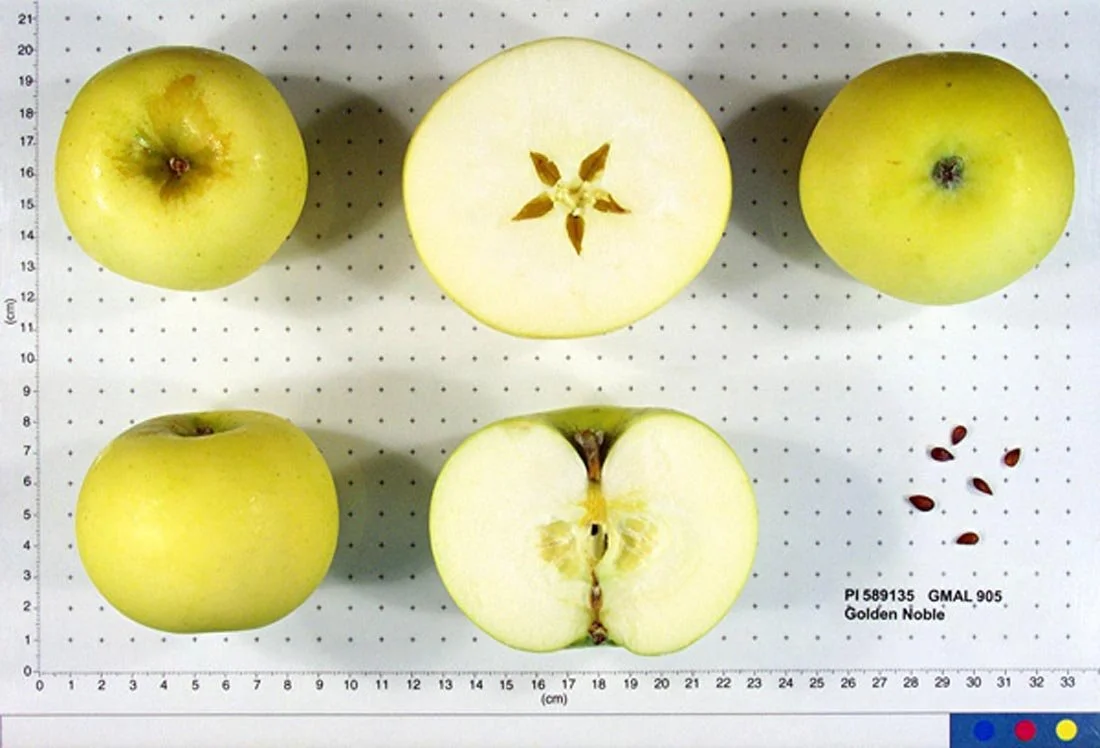





This apple was developed in Japan in the mid-1900s - also known as Tohoku 3. These red apples are on the smaller side but packed with flavor when harvested just right. They hang well on the tree so it’s best to harvest as late as possible for enhanced flavor. They don’t keep as long in cold storage so are best for eating right away. Great for fresh eating, this apple is also fantastic in sauces, pies, and dried. Late harvest period.
Note: this apple scionwood is harvested from Fordyce Farm inc. that we operate in Salem, OR. Fordyce Farm inc. is not certified organic.
Categories: dessert apple, baking/saucing apple
Tags: Disease-resistant, Harvest period mid, Pollination Group D